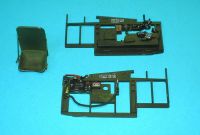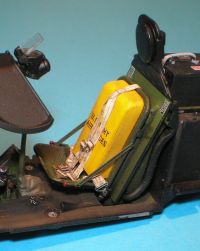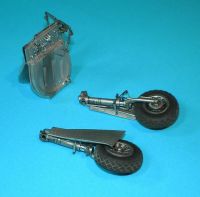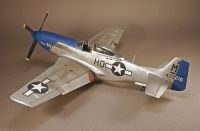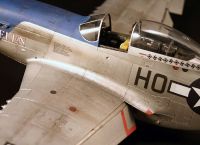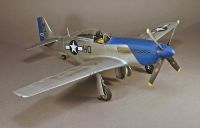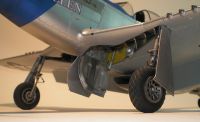Tamiya 1/32 Mustang - "Miss Helen"
By Guy Wilson
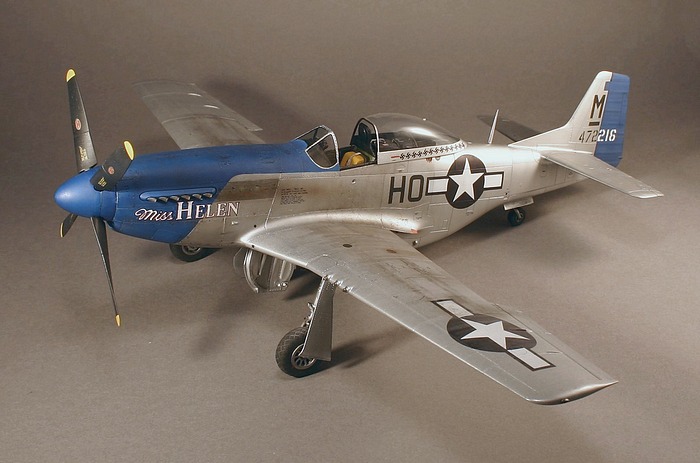
When I learned that Tamiya were launching a P-51 Mustang in 1/32nd scale I expected big things. As soon as the kit was launched I began reading on-line reviews and builds which increased my excitement to the point where I eventually succumbed and bought one. This was a deviation from my usual path of modern jets but the idea of building one of Tamiya's modern uber kits was too hard to resist.
When I got the model home I felt like a teenager again, all fingers and thumbs fumbling at the box in eager anticipation. I wasn't disappointed. Beautifully packed and full of all sorts of goodies this box had me brimming with delight. In truth, I couldn't wait to get started and sidelined other projects immediately.
Before I began I considered my options. On one hand I could spend a great deal of time and effort on research to build an accurate block Mustang. On the other, I could build pretty much what was in the box and just enjoy the experience. Since I was already knee-deep in a long and exhausting build I chose option #2. Of course I had already absorbed certain elements from reading the on-line threads so all that was left to do was begin.
I followed the suggested assembly steps as it would be easy to get off track with a kit this complicated. The engineering of the plastic has to be seen to be believed. Considering the restrictions involved injection molding, Tamiya have done a marvellous job with this model.
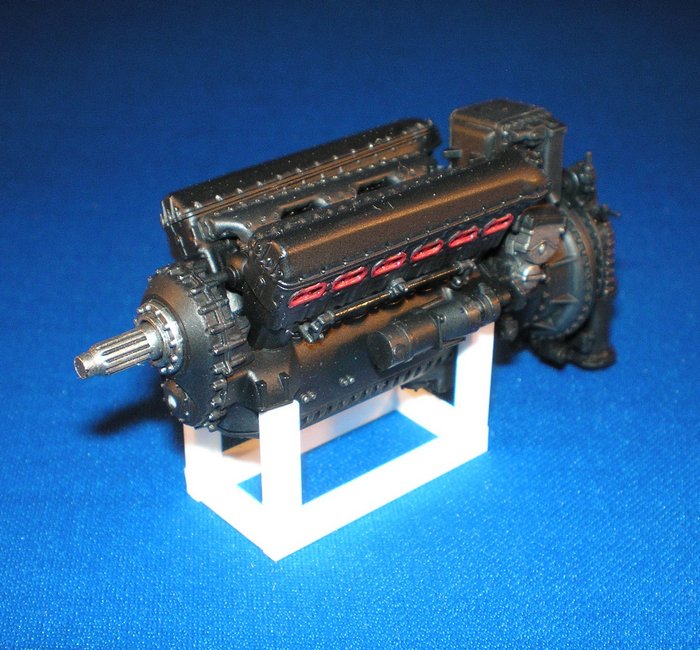
The first area of construction is the engine. What a beauty! In fact, this motor is so good I couldn't face hiding it away inside the nose of the aircraft. Instead, I assembled and painted it with a view to displaying it alongside the finished model on a custom made stand. Tamiya do allow the modeller to remove the wafer thin cowls using mini magnets but I couldn't see myself ever playing with the completed kit once it was positioned in the display cabinet. Thankfully, it is possible to construct the nose of the model without the engine fitted.
The cockpit builds quickly and effortlessly and looks nice and busy. Tamiya require the builder to choose which airframe to construct very early on and it is particularly important to follow the instructions to make sure each component is used correctly. With three different airframes to choose from, some parts won't be used.
I primed the plastic in black then sprayed various greens at an oblique angle to accentuate the shading. A final light dry brush over the topmost edges with the lightest shade of green helped the detail pop. Tamiya offer on or two decal data placards for the cockpit tub and seat but I spent some cash and bought the Barracuda Studios set which adds so much more.
Whilst I was searching the net for aftermarket parts I found some HGW seat belts. These are more easily manipulated than the Tamiya etched metal versions and with a bit of care assemble into a convincing replica of the real deal.
With the cockpit complete the next stage is the intake trunking and radiators. Tamiya provide etched metal for the radiators but I opted for the RB productions version which are finer gauge. Radu's set also gives an etch part for the canopy rail which is a nice bonus.
So it came time to join the fuselage halves. The fit of parts is exemplary and the only area where extra attention may be required is the short seam beneath the intake. As I assembled the model I found myself marvelling at the fit all the way along. Separate panels on the fuselage that will allow other Tamiya releases in the future fit so well that the joins appear identical to the deftly sculpted recessed panel lines. The gun cover panels in the wing are the same. I chose to keep the panels closed for this model but the gun bays and ammunition feeds are all included in the kit.
I was eager to get to the wheel bays next. My fingers were itching after I'd studied other on-line builds and I wasn't disappointed. Once again the parts fitted perfectly and little or no adhesive is required. There is much debate on the net regarding actual wheel bay colouring. I've seen modellers depicting full green bays, full yellow bays, part bare metal and part coloured. In fact, any combination which the builder feels happy with. The option I chose was simple. Predominantly bare metal but with a yellow chromate main spar. The mounting of the main gear is very strong and like everything else in the kit fits like a glove.
Tamiya thoughtfully provide the whole of the underwing as one component and the dihedral is taken care of by a robust plastic spar so it is easy to achieve the correct look. The upper wings meet the fuselage in an air tight fit so no filler is required at all. Careful sanding of the join around the edge of the wing makes the seams completely disappear. The ailerons, elevators and flaps are all movable but the fit of the ailerons was quite loose so I glued them in a neutral position on this model.
At this point I quickly found myself with a built up Mustang. It had taken a very short time to get to the painting stage which was entirely due to the skill and thought that the engineers at Tamiya had put into the kit. This model is definitely at the pinnacle of modern injection molding technology.
So, what scheme to choose. There are myriads of beautiful P-51Ds in the world and the choice of markings are legion so careful thought is needed. When I was much younger my dad helped me build the large 1/24th scale Airfix model of "Cripes-a-Mighty" and as a result I have a fondness for the blue nosed birds. Tamiya offer "Petie 2nd" as one of the kit decal options yet I wanted something less overt than either Cripes-a-Mighty or Petie. A quick search resulted in a suitable alternative, namely "Miss Helen".
Miss Helen was the mount of Capt. Raymond Littge and named after his girlfriend. Sporting the familiar blue nose scheme of the 352nd FS the remainder of the markings appeared more subtle to me which I preferred. The next problem was sourcing the correct markings. Thankfully, Ian of Ad Astra masks came to my rescue. Within a week Ian had drafted artwork, sent it to me electronically for approval and created the custom decals and masks for my chosen scheme. I received them very promptly and set about using paint masks for the first time. Fortunately for me the masks work beautifully and give a super effect. I suspect that if I'm able to source masks for future projects I may be using Ian a great deal in the future.
Bare metal finish is often a challenge. There are many mediums that give a shiny silver surface. Some are easy to use, others less so and it comes down to personal preference on behalf of the modeller as to which path they choose. I think if things were different I'd probably use the Alclad II range of lacquers for NMF. I've seen the results of these paints on display at various model shows and they are very convincing. However, lacquer paints are notoriously pungent with powerful fumes and since I spray inside without much in the way of extraction equipment I was forced to look at other alternatives. I settled for the acrylic paints in the Citadel Miniatures range available through Games Workshop outlets. These metallics have a very fine pigment and spray well even when thinned with water. Thankfully they are all but odourless too which is a major boon.
I used the lightest of the silvers (Mithril silver) for the main airframe then picked out the panels aft of the exhaust in the darkest shade, Boltgun metal. I even used Citadel Miniatures Necron abyss foundation colour for the blue on the nose and rudder.
With the major markings taken care of by Ian I needed an alternative to the kit airframe stencils. I found the Tamiya decals to be too thick for normal use. In order to get the decals to appear painted on I think it would have taken numerous layers of gloss and flat to disguise their thickness, something I wanted to avoid on a NMF. This time my saviour was HobbyDecal who provide a set of dry transfers for P-51 stencils. (I bought mine through Sprue Bros.) I've used the Hobbydecal product before and was just as happy this time round. The dry transfers give a satisfyingly "painted on" look once applied.
The last job was a bit of weathering. This is where my lack of knowledge let me down. I am unfamiliar with how much weathering these airframes endured so I used builds by Ron and Ralph here on LSP as inspiration. I used pastels and LifeColor TensoChrom weathering inks sparingly to give a suggestion of use without going over the top. I'm not sure of the accuracy of the result but I'm happy with how it looks in the display case.
With the model complete I can sit back and enjoy the fruits of my labour. Is the Tamiya Mustang perfect? For me, not quite. The etched frets are somewhat crude when compared to the level of finesse and delicacy of the injection plastic. The kit decals are overly thick to my mind and not up to the high quality of the kit. Perhaps Tamiya could look to a different source for their decals in future? However, setting those very minor comments aside I can safely say that this was the most enjoyable model that I have ever had the pleasure of building and I'd build another in a minute.
Treat yourselves, you won't be disappointed.
Cheers,
Guy
© Guy Wilson
This article was published on Monday, February 13 2012; Last modified on Saturday, May 14 2016

